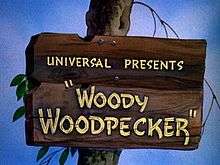Woody Woodpecker (1941 film)
| Woody Woodpecker | |
|---|---|
| Woody Woodpecker series | |
 | |
| Directed by | Walter Lantz |
| Produced by | Walter Lantz |
| Story by |
Ben Hardaway Jack Cosgriff |
| Voices by |
Mel Blanc Sara Berner Bernice Hansen Margaret Hill-Talbot Danny Webb (all unc.) |
| Music by | Darrell Calker |
| Animation by | Walter Lantz |
| Studio | Walter Lantz Productions |
| Distributed by | Universal Pictures |
| Release date(s) | July 7, 1941 (U.S.) November 18, 1988 (with The Land Before Time) November 25, 2012 (with The Land Before Time 3D) |
| Color process | Technicolor |
| Running time | 6' 55" |
| Language | English |
| Preceded by | Knock Knock |
| Followed by | The Screwdriver |
Woody Woodpecker is the first animated cartoon short subject in the Woody Woodpecker series. Released theatrically on July 7, 1941, the film was produced by Walter Lantz Productions and distributed by Universal Pictures.[1]
This is the second appearance of Woody Woodpecker; his debut was in an Andy Panda cartoon, "Knock Knock".
The working title of this cartoon is 'Cracked Nut'.
Plot
The inhabitants of the forest that Woody Woodpecker (Mel Blanc) lives in have started spreading the word that Woody is crazy, due to all of his screwball antics. After telling him (and many others) this several times, Woody also begins to question his sanity. Woody Woodpecker spends his day singing loudly and pecking holes in trees. He infuriates the other woodland creatures - when he isn't baffling them with his bizarre behavior. Woody overhears a squirrel and a group of birds gossiping about him. Even though he just sang a song proclaiming his craziness, he denies their whispered accusations that he's nuts. But after they trick him into knocking his head on a statue, the poor bird hears voices in his head and decides the animals might be right. He decides to see a doctor. But leave it to Woody to choose Dr. Horace N. Buggy, a Scottish-brogue-burring fox, who is, if it's impossible, even madder than he is.
Critic
When Woody Woodpecker debuted as an antagonist for star Andy Panda in KNOCK KNOCK in 1940, his zany antics immediately captivated audiences. Shrewdly aware of the woodpecker's star potential, producer Walter Lantz cast him in his first solo cartoon, WOODY WOODPECKER. Under Lantz's uncredited direction, this cartoon discharges an authentically wacky and convulsive energy that's reminiscent of the contemporary Warner Brothers cartoons. Indeed, one of the writers, Ben "Bugs" Hardaway had worked at Warner's before Lantz hired him. Most of the energy comes from Woody himself. He represents the uninhibited id as he darts all over the screen, pulls prankish stunts, sasses his antagonists, and employs his trademark laugh. And what an appropriately outrageous design for an outrageous character with his extremely long bill, buck teeth, goofy eyes, stumpy legs, and a garish mixture of blue, red, yellow and green all over his body. The brilliant Mel Blanc provides an appropriately loony voice that is as oddly endearing as it is funny. Thank to Blanc's work and the skillful animation, Woody Woodpecker never seems obnoxious; just a lovable nut. One senses his comic aggressiveness is not derived from malice but from a naturally manic temperament.
Undoubtedly the highlight is in the beginning when Woody sings "Everybody Thinks I'm Crazy." The lyrics aren't sensationally funny, but Darrel Calker's jaunty music, Blanc's hilarious singing, and the comical animation of Woody's strutting make this a showstopper. In fact, this song would be Woody's theme in his early cartoons.
Mel Blanc would've undoubtedly remained the voice of Woody Woodpecker until his death if Warner Brothers hadn't given him an exclusive contract. (However, he did later did Woody's voice on some children's records.) It's a pity because of all the actors I've heard do the woodpecker (I never heard Billy West's work on THE NEW WOODY WOODPECKER SHOW, Blanc was the most impressive. He conveyed a charismatic craziness that none of the other actors I've heard could capture. Although Lantz continued to produce fine Woody Woodpecker cartoons for some time, I feel the woodpecker lost a little pizazz when Blanc was replaced.
References
- Cooke, Jon, Komorowski, Thad, Shakarian, Pietro, and Tatay, Jack. "1941". The Walter Lantz Cartune Encyclopedia.